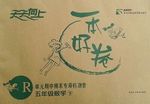题目内容
【题目】What will the man probably do tonight?
A. Read Chapter 4. B. Study in the library. C. Watch the football match.
【答案】C
【解析】
M:Hi, what's the homework for the literature class? I missed it today.
W:We are supposed to read Chapter Four.
M:Great! I have read it when I was studying in the library last night.
W:Wow, lucky you. You can watch the football match tonight!
M:That is right!

练习册系列答案
 天天向上一本好卷系列答案
天天向上一本好卷系列答案 小学生10分钟应用题系列答案
小学生10分钟应用题系列答案
相关题目